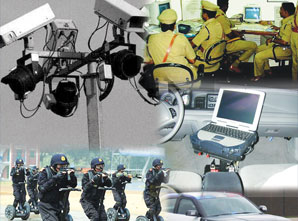
Police forces across the country are modernising and adopting new methods and technologies in order to carry out their mandate in a better way. egov presents a brief overview of police modernisation programmes in India and views of some key people involved with police modernisation projects.
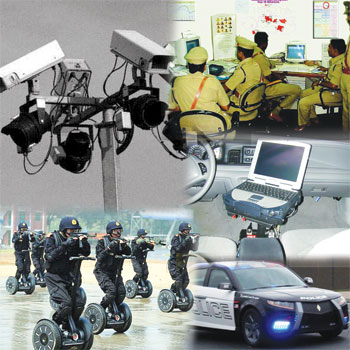 Police being a state subject under the constitution of India, it is the primarily responsibility of state governments to take care of the requirements of respective police forces, including those related to modernisation. The Union Ministry of Home Affairs (MHA) supplements efforts of the state governments through grants and also technical assistance. It also carries out modernisation activities directly for the Central Police Forces. Police Modernisation has been included as an Integrated Mission Mode Project (MMP) under the National e-Governance Plan (NeGP). The establishment of a nationwide Crime and Criminal Tracking Network and Systems (CCTNS) is a major initiative being undertaken under the MMP presently. In addition, a number of other initiatives are also underway. The basic objective of the MMP is to meet the identified deficiencies in various aspects of police administration, worked out in 2000 by the Bureau of Police Research and Development (BPR&D) in a study, according to which a requirement of about Rs.25,000 crore, was needed for the purpose. The MHA has also undertaken a scheme of Mega City Policing (MCP) under which police forces in seven cities – Mumbai. Bangalore, Hyderabad, Chennai, Delhi, Kolkata and Ahmedabad are being modernised.
Police being a state subject under the constitution of India, it is the primarily responsibility of state governments to take care of the requirements of respective police forces, including those related to modernisation. The Union Ministry of Home Affairs (MHA) supplements efforts of the state governments through grants and also technical assistance. It also carries out modernisation activities directly for the Central Police Forces. Police Modernisation has been included as an Integrated Mission Mode Project (MMP) under the National e-Governance Plan (NeGP). The establishment of a nationwide Crime and Criminal Tracking Network and Systems (CCTNS) is a major initiative being undertaken under the MMP presently. In addition, a number of other initiatives are also underway. The basic objective of the MMP is to meet the identified deficiencies in various aspects of police administration, worked out in 2000 by the Bureau of Police Research and Development (BPR&D) in a study, according to which a requirement of about Rs.25,000 crore, was needed for the purpose. The MHA has also undertaken a scheme of Mega City Policing (MCP) under which police forces in seven cities – Mumbai. Bangalore, Hyderabad, Chennai, Delhi, Kolkata and Ahmedabad are being modernised.
CCTNS is a Rs 2,000 Crore Project

 S Suresh Kumar, Joint Secretary (Center State), Ministry of Home Affairs, Government of India
S Suresh Kumar, Joint Secretary (Center State), Ministry of Home Affairs, Government of India
The Crime and Criminal Tracking Network and Systems (CCTNS) project is a Rs 2000 crore project. Spread over an implementation span of 5 years, it involves 35 different units and more than half-a-dozen other stakeholders in the government. It has been a challenge to get the stakeholders to agree upon diverse issues that are thrown up from time to time. Every stakeholder has their own perspective on how the project should evolve. Now getting the entire thing aboard and moving is a major challenge.

The project has faced some criticism on aspects such as delay, growth and so and so but the overall vision and the roadmap that has been laid down for the project, has to an extent, been working out well. It is going on according to a certain plan and in a measured manner. Hopefully we should see the implementation stage being completed in the coming couple of years. Any project of this scale would in my view start as a small pilot and then grow into the wide area network encompassing many cities, many states, probably get onto the Internet and maybe become worldwide in scale.
The issue of security is definitely one of the major issues to be addressed in any policing project not just CCTNs. It is just a project that most of the police forces in India are implementing. Issues related to data protection, how you look at your data and what is the level of access accessibility you have given to the people and what you try to protect is something extremely crucial. There are also best practices available for the data security and integrity.
We seem to Reinvent the Wheel Again and Again
 Raj Prem Khilnani, DGP (Homeguard and Civil Defence), Maharashtra
Raj Prem Khilnani, DGP (Homeguard and Civil Defence), Maharashtra
The Policing establishment is primarily citizen centric and public centric service setup. The idea is to have an efficient and satisfactory system. With technology interventions, policing services have become more efficient. There has to have a process excellence built around the system. In Maharashtra, we have been working on the computerisation of the police force and the police department for quite some times now. Earlier we were working on Common Integrated Police Application (CIPA) and then we switched over to CCTNS. The progress has been slow but gradual. But nevertheless we cannot get disheartened. The problem that I see is that the technology advances very fast and administrative setup like the police, which tries to adapt the technology and integrate with its traditional working systems, cannot match up with the pace and time.
The other issue that I would like to highlight is we seem to reinvent the wheel again and again. In the context of policing, the areas of application are more or less similar whether it is United States or Europe or any other part of the globe. Instead of reinventing the wheel entirely what we could do is to have suitable modifications and adaptation of technology catering to our home conditions.
The private sector and technology companies are key stakeholders. Unless all the stakeholders work in greater harmony, we cannot see the success of any project.
NCRB should make Data Available across India
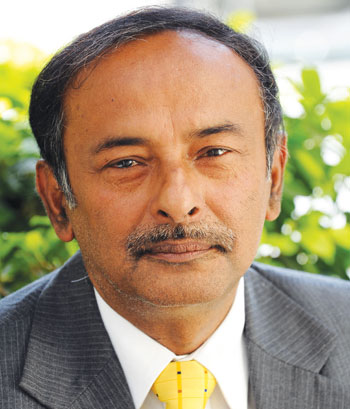
S K Basu, Vice President, NIIT Technologies
The government is spending a large amount of money on police modernization. On CCTNS alone, it is supposed to spend Rs 2000 crore. There can be another 500 crore spent on upgrading general IT infrastructure. If one takes paramilitary organistions like CRPF, BSF, ITBP, SSB, NSG, etc into consideration, it will be another 500 crore being spent.
Modernisation will make available all data in time, so that senior hierarchy can analyse and take informed and timely decisions. FIRs can be processed faster & tracked easily. Response to queries of citizen will be faster and more accurate. Criminals can be profiled and crime type can be analysed to track criminal faster/predict type of criminal to solve cases faster.
“The project has faced some criticism on aspects such as delay, growth and so and so but the overall vision and the roadmap that has been laid down for the project, has to an extent, been working out well”
In order to further improve the rate of technological advances in police forces, the National Crime Record Bureau should make available access to data from any state across India, from a central database.
Criminal profiling should be done so that predictive policing can be implemented for all critical crimes impacting society & good living. Police officers should be provided gadgets like Personal Digital Assistants (PDA) so that police can note the details of finding at a location on the system for faster data capture and processing.
NIIT Technologies is involved in modernisation projects with the BSF and CRPF, and with state police in Jharkhand, Tamil Nadu and Odisha for CCTNS. We would start working with Uttar Pradesh Police shortly.
The Police Department and Government Agencies lack Effective Mechanisms to Absorb Technology
 Rajvir P Sharma, Additional Director General, Bangalore Metropolitan Task Force
Rajvir P Sharma, Additional Director General, Bangalore Metropolitan Task Force
Issues related to public safety and security of vital infrastructure have been vigorously deliberated after 9/11. After 9/11, most of the countries introspected on their security apparatus and started working on mechanisms and effective databases as well as developing the capacity to analyze and use the data.
The 9/11 review concluded that although intelligence about the terror attacks, action could not be taken due to lack of analytical capabilities. Following this, the US government invested in building this capacity and today the American have made themselves reasonably safe.
In India, the police department has passed through three phases i.e. documentation of data, the present one, CCTN , and CIPA which was tried earlier. The cost involved in keeping these system alive and updated is going to be much higher than expected what we probably need is a proper documentation of plan work.
|
||||
We conducted a survey to measure the level of technology adoption in police, and found out that the police department and government agencies lack effective mechanisms to absorb technology; the Police and government machinery are not sufficiently security enabled and that there is lot of wastage of resources in absorbing or by absorbing outdated technology.
Merely cosmetic adoption of technology is not going to help. We need to ensure real adoption of technology if the true effects are to be realised. When we look back at our computerisation of the police department, we had been changing the mechanism of data collection every time in all three systems. We should have had a policy which should be relevant and valid for at least a decade or two.
We would be able to Catch People Sitting on Computer
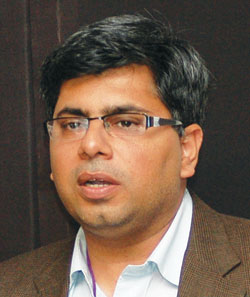 Sharat Kaviraj, Deputy Commissioner of Police, Jaipur West, Rajasthan
Sharat Kaviraj, Deputy Commissioner of Police, Jaipur West, Rajasthan
At the time of my posting as a Superintendent of Police in the Crime Branch, our Director General instructed that we have to bring down the pendency of cases and I was asked to monitor pendency of cases in Rajasthan. The report data was outdated and unreliable. With the help of friends in the IT Department, we started with a very small project. This was a very simple application and we invested practically nothing. Once the forms were online, reports started being sent by email and within 15- 20 days of this project, I was getting pendency report across Rajasthan on daily basis. So this was major success.
Another initiative that comes to mind is the work we did with standing warrants. When we started, we had 55,000 standing warrants lying open across Rajasthan. We started with a very simple idea that if every police station could apprehend the standing warrantee living in his own area, this could lead to good results. We put a basic online system in place and in two months we closed more standing warrants than we had been able to in the preceding 5-6 years! Policeman were still policing their own area, one simple IT application changed the whole game.
One often comes across crimes that have been planned in jails. Criminals have access to mobile phones inside jails and in the absence of a proper infrastructure, the police cannot detect such cases. A huge number of SIM cards have been activated on false addresses and there is no system in the country to tell whether these addresses are genuine or not. There is no system to track patterns and trigger alarms. We don’t have systems that can trigger intelligence related alarms and alerts the police when an ATM stops working. Similar for power theft, the power grid knows this particular section of the line has been tripped but we won’t know and there is transmitter theft which is taking place.
For proper security, and efficient policing, all the related systems need to come together on a common platform. CCTNs, when it becomes operational, would be something like the Aadhar for police applications. One is really looking forward to the CCTNS. Once the whole application is online, I am sure in some years, things would reach a state when it would not be a fairy tale to say that we would be able to catch people sitting on computer.
Boundaries are no more Barriers for Criminals
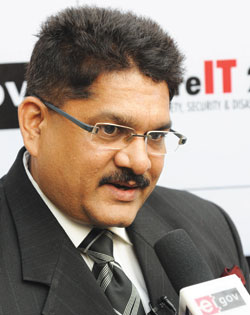 Purushottam Sharma, Inspector General of Police, Madhya Pradesh
Purushottam Sharma, Inspector General of Police, Madhya Pradesh
CCTNS is the focal point of e-Governance initiatives in police forces across India. The project has been conceptualized as having three layers – at the bottom layer are the assets – the hardware and some software, and the database. The middle layer is business intelligence logic which is nothing but core application software. The top layer is the user environment which is nothing but access control where public will come and access and enter into the second layer get the information and get the whole thing done. This will be in nutshell is a core model for the CCTNS.
We are now laying emphasis on integrating all the states because boundaries are no more barriers for criminals. Criminals are moving from state to state and committing crimes. It is basically to provide good governance in terms of connecting all the states, the whole country will be one police station. Once the system is in place, we would be able to track criminals throughout the country. The tracking will be done by having fingerprint biometrics, by using different biometrics like face and others. Trust and accountability will be achieved when we really bring out and bring success to the system.
The NCRB is implementing a change management system and helping states move from the traditional methods of working to sophisticated systems. Lack of security awareness and capacity are some major challenges that one faces when working on change management, and these issues have to be addressed systematically. Interoperable standards that are common across the country also need to be devised, as in the absence of standards, the whole network would be of not much use.
Modify Police Forms to include Information about UID and Mobile Number
 Ranjan Dwivedi, Inspector General, Police Recruitment Board, Uttar Pradesh
Ranjan Dwivedi, Inspector General, Police Recruitment Board, Uttar Pradesh
The CCTNS is going to impact police operations in the country in a very positive manner. One hopes to see it in place soon. The core CCTNS module can be enhanced through application plugins that address specific functions, some of which are: Talash for missing person reports; motor vehicle coordination; automated fire-arm coordination; automated finger print identification system and Seva 100 for coordination of Police Control Room functioning and response. An automated ballistic identification system is should also be developed on the lines of these applications.
In order to enhance the benefits accruing out of investments being made in police modernization, some steps need to be taken. The important ones among these are: move to open standards and software; integration of the communications and IT wings into a ICT Department; modifying forms to include fields for UID (Aadhar) and mobile number; reworking of the training curriculum to enhance importance of ICT and provision of smart phones for the constabulary. These will help in better information management, capacity building and ready access to data and more effective monitoring.
We also need to move aggressively and develop Indian language computing protocols and standards for mobiles and enforce interoperability across Service Provider Networks and access devices, with mandatory disclosure of subscription to these standards. Modern GIS technology should be integrated in crime management, jurisdiction planning and determining location of new facilities in order to optimise returns on investments and deliver better services to citizens. Similarly, much greater use of technology can be made in police recruitment. This will speed up the process and also make it more transparent.
CCTNS Applications would work in Offline Mode
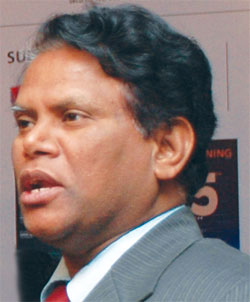 P R K Naidu, Joint Director, National Crime Records Bureau
P R K Naidu, Joint Director, National Crime Records Bureau
CCTNS applications are being developed in a way that they work offline as well. While BSNL would be providing connectivity across the country, since power is the huge problem in the country, there is no guarantee that we will have robust network all the time, looking at all 21,000 locations in the country. That is why the applications would work in offline mode and when the network is up and running then all the data can be synchronised with state data centres and the national data centre. We don’t have adequate resources for networks – only 5 percent of the project outlay has been approved for the network whereas industry standards say it should be 15 percent. The DIT is helping out in a big way and have offered us the use of their SWANs that have been built at a cost of Rs 3,500 crore.
Be a part of Elets Collaborative Initiatives. Join Us for Upcoming Events and explore business opportunities. Like us on Facebook , connect with us on LinkedIn and follow us on Twitter, Instagram.











